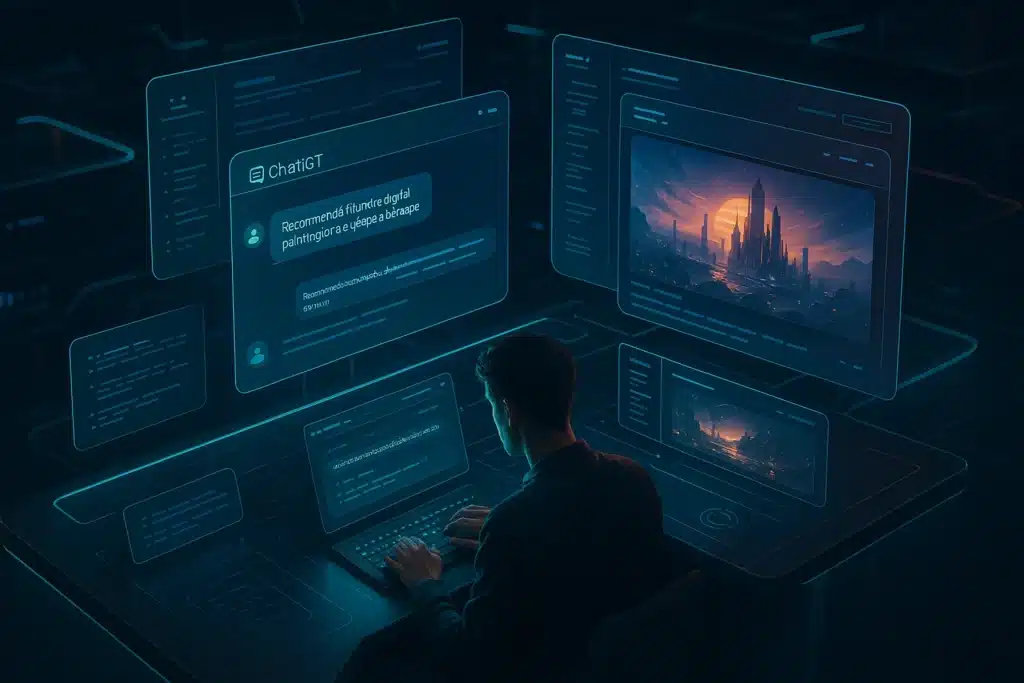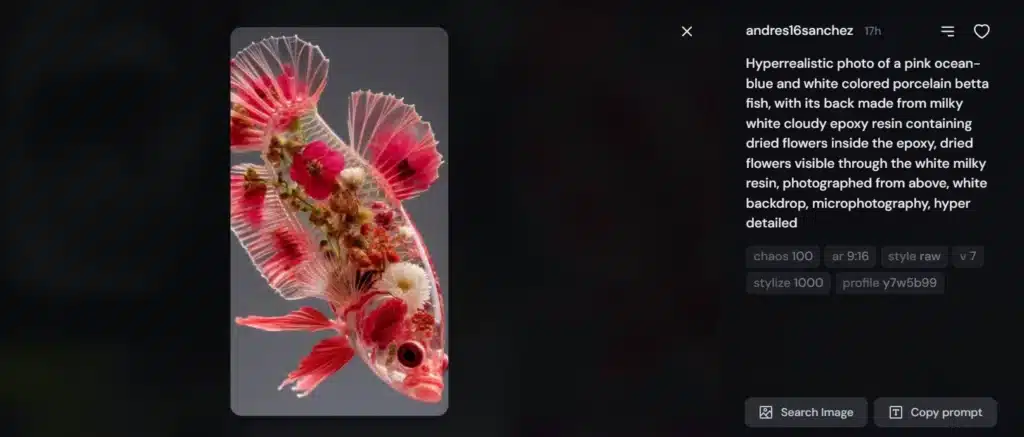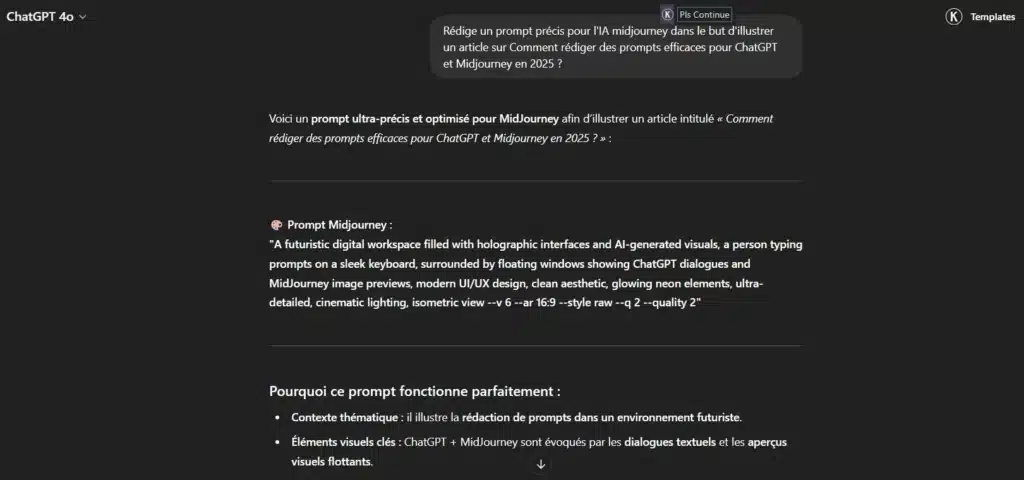Writing prompts for ChatGPT or Midjourney won’t be the same thing! ChatGPT excels in generating detailed, structured text, while Midjourney creates impressive images and illustrations.
Both are generative AIs, i.e. they automatically produce new, original and coherent content based on the (precious) indications provided by the user. Prompts are therefore written in a different linguistic register: text for one, images for the other.
A well-designed prompt can make all the difference between a generic response and content that meets your expectations. This article clearly explains the fundamental differences, both in form and content, between prompts designed for ChatGPT and those designed for Midjourney.
In particular, you’ll discover how to structure these prompts effectively, as well as the essential keywords to use to achieve the best results with each AI!
The fundamentals of an effective prompt
A prompt is an instruction or initial request given to a language model for a specific response or content. The prompt is the starting point that guides the AI in generating the text or image, directly influenced by the user’s choice of words and phrases.
The quality of your prompt largely determines the relevance of the result obtained! As you know, poorly designed prompts often result in somewhat disjointed or even irrelevant AI responses…
Prompt AI: why precision and context are essential?
Specific details in your prompts help AI models understand exactly what you’re asking, enabling them to generate more relevant answers. If a prompt isn’t specific enough, the AI may give a general or irrelevant answer.
An example of a precise prompt
For example, instead of simply asking “Give me a training program”, specify: “Write a detailed training program for a beginner runner preparing for a 15-kilometer marathon. The program should focus on weekly distances to be covered, rest days, speed training and specific exercises to improve general fitness”.
Use clear, direct language
Simplicity will make the difference for a prompt. Avoid ambiguous or overly complex wording that could be misinterpreted by the AI: direct sentences and clear instructions.

The prompt difference between Midjourney and ChatGPT
Prompts for Midjourney and ChatGPT are fundamentally different: one generates text while the other generates images. The basic structure is just as different! Here’s a reminder of the basic structure of a good AI prompt for ChatGPT and that for Midjourney.
For more advanced Prompt Engineering techniques, especially for ChatGPT, please see our article Prompt Engineering: creating effective AI prompts (ChatGPT, Claude, Gemini)!
ChatGPT: structure of an effective prompt
- Mention the role: “You’re a B2C marketing expert…” ;
- Identify the task: “…your mission is to write a prospecting email…” ;
- Describe the context: “…for an e-commerce site specializing in candles…” ;
- Set constraints: “…with a formal tone, no more than 80 words, no technical jargon, and a clear call-to-action”.
Midjourney: structure of an effective prompt
- Describe the subject: “a majestic lion…”.
- Add the artistic style: “…inspired by Van Gogh…”.
- Specify the environment: “…in a lush jungle…”.
- Mention the composition: “…with a portrait close-up”.
Prompt IA: list of good keywords and action verbs for ChatGPT and Midjourney
So, you’ve noticed the difference in prompt structure between ChatGPT and Midjourney AIs . Let’s get down to the details of keywords and action verbs for ChatGPT and Midjourney with some examples.
Don’t hesitate to test different formulations to fine-tune your results!
Example of keywords for prompt Midjourney
Midjourney will require a combination of visual words, artistic styles and clear structure for artistic prompts. This requires descriptive keywords, which are specific adjectives and terms related to the art world:
- Vibrant, colorful, muted, monochromatic for colors.
- Complex, detailed, minimalist, abstract for the artistic style.
- Soft, ambient, neon, studio lights for lighting.
- Soft, ambient, neon, studio lights for lighting.
To guide Midjourney’s artistic creation, you can use artistic verbs such as ” draw ” or ” sketch “, which will influence the technique used by the AI, or ” render “ for a precise finish quality.
You can also mix different artistic styles or incorporate historical or artistic references.
As with ChatGPT, include what you don’t want in your image!
Prompt structure table and Mijourney keywords
| Steps to a prompt Midjourney | Examples of useful keywords |
| 1. The main subject (what you want to see) | “a portrait of….. “”A scene depicting…”, “Illustration of…” |
| 2. Artistic style | “Watercolor style”, “Realistic oil painting”, “Pixel art illustration”, “Art deco”. |
| 3. Visual details | “Bright colors”, “Subdued light”, “Strong shadows”, “Very detailed”, “Minimalist”. |
| 4. The ambience | “Cheerful atmosphere”, “Dark and mysterious ambience”, “Futuristic setting”, “Retro style”. |
| 5. Composition | “Close-up”, “Panoramic view”, “Low angle”, “Isometric perspective”. |
| 6. Specific keywords | “Enchanted forest”, “Cyberpunk technology”, “Portrait of a samurai”, “Night cityscape”. |
| 7. Parameters (to modify shape and quality) | “–ar 16:9 (aspect ratio)”, “–q 2 (quality)”, “–v 5 (Midjourney version)”, “–stylize 700 (stylization level)”. |

Example keywords for prompt ChatGPT
The best prompts for ChatGPT are those that use precise action verbs and descriptive words to direct the AI towards a specific task or get it to conform to the reasoning you want it to.
The action verbs to focus on in your prompts are going to be verbs like :
- Analyze: To request an assessment or in-depth study ;
- Explain: For detailed clarifications ;
- Compare: Ideal for comparing two concepts or ideas;
- Detail: For an exhaustive, in-depth answer ;
- Summarize: Useful for synthesizing large amounts of information;
- Illustrate: For concrete or visual examples;
- Demonstrate: To prove or argue a point;
- Create: To generate original content, such as texts or ideas ;
- Lister: To obtain a structured list of items.
Next, you need to use precise adjectives to improve the quality of ChatGPT responses:
- Detailed, thorough, clear, structured for a complete answer;
- Concise, synthetic, summarized for a short, targeted response;
- Chronological, logical, popularized to adapt the tone to your audience or needs.
ChatGPT prompt structure and keywords table
| Steps to a ChatGPT prompt | Examples of useful keywords |
| ” . The role (who you want it to be) | “You’re a marketing expert…”, “Act like a financial consultant…”, “You’re an art historian…” |
| 2. Action (what you want ChatGPT to do) | “Analyze…”, “Compare…”, “Detail…”, “Explain…”, “Summarize…”, “Create a list of…” |
| 3. The subject (what you’re talking about) | “Current trends in the cybersecurity market”, “The benefits of teleworking”, “The history of the Italian Renaissance”. |
| 4. The goal (what you want to achieve) | To help me understand…”, “To prepare a presentation on…”, “The aim is to write a report on…”. |
| 5. Form (how you want the answer) | “In the form of a bulleted list”, “Using detailed paragraphs”, “A structured text with an introduction and a conclusion”. |
| 6. Style (how the text should look) | “In a formal manner”, “With a friendly tone”, “Journalistic style”, “Technical language”. |
| 7. Length (how many words or points) | “In 500 words maximum”, “In 5 key points”, “Summary in 100 words”. |
| 8. Important rules (do’s and don’ts) | Don’t forget to include concrete examples”, “Always include recent references”, “Without using technical jargon”. |

Examples of effective prompts: ChatGPT and Midjourney
Finally, there are different types of prompts for both ChatGPT and Midjourney. Each prompt has a specific purpose and uses a structure that is adapted to the capabilities of the chosen AI model. In the two sub-sections that follow, we present a few examples for ChatGPT and Midjourney:
Prompts for ChatGPT
- Analytical prompt: “Analyze the advantages and disadvantages of teleworking for medium-sized companies. Structure your answer in distinct sections with subheadings, and end with a conclusion summarizing the key points. Use an objective, factual tone;
- Creative prompt: “Write a 500-word short story about an unexpected encounter in a Parisian café. The protagonist should be an American expatriate and the story should include an element of mystery. Use an elegant literary style with sensory descriptions.”
- Informative Prompt: “Explains the concept of blockchain to a 15-year-old who is interested in the technology, but has no prior knowledge of the subject. Use simple analogies and accessible vocabulary.”
Prompts for Midjourney
- Prompt for a stylized portrait: “Paint a knight in a nighttime cityscape, wearing on his armor, in cinematic lighting;
- Prompt for a fantastic landscape: “large labyrinth, à la Escher, ornaments, hedges, Art Nouveau”;
- Prompt for a conceptual character: “Old mystical warrior, face in profile, fantasy, magic, shiny runes, tattoos, details, mist, digital art style like Artgerm, Bak, Bokey” ;
- Prompt for a minimalist image: “tiny cute adorable ginger tabby kitten studio light”.




